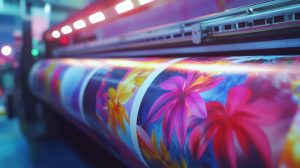Production printing has come a long way in recent years. Traditionally, businesses that wanted high-quality print materials had to rely on offset printing. This process is known for its precision but is also terribly complex, expensive, and time-consuming. Smarter technologies have shifted the way production print looks for many businesses. That’s where digital production printing comes in.
The shift from offset printing to digital printing presses is not without reason. Many businesses are facing pressure to deliver more personalized experiences to customers, respond quickly to market changes, and minimize waste without sacrificing quality. The goal is to encourage engagement among audiences and have the flexibility to make quick changes to print jobs. With advanced features integrated in the digital printing press, businesses can easily meet these challenges.
In this blog, we’ll compare how transitional offset and digital production printing work for businesses, and explore the key advantages of going digital. We’ll also dive deep into a real-world example showcasing how digital production printing transformed production times and print quality for an American business. By the end, you’ll have all the information you need to make an informed decision about whether adopting a digital printing press is right for your business.
Traditional Offset Printing vs. Digital
How exactly does traditional offset printing differ from digital production print? Thanks to new technology innovations, these two approaches are vastly different. Offset printing refers to a labour intensive task of transferring ink from a plate and then onto paper. It requires planned setup time for creating the plates, calibrating color, and adjusting ink, which increases product and labor costs. This approach also limits the level of personalization and flexibility businesses can make for specific print jobs. You would typically see businesses using the traditional approach for large-volume materials like newspapers and packaging.
Digital production printing is a more advanced approach to production print and has become the modern standard. It eliminates the need for plates entirely, and instead uses digital files to feed images directly to the printer. Not only does this cut down setup time that you’d see in traditional printing, it enables businesses to redesign prints and personalize them easily. Digital production print is ideal for fast-paced environments that typically require short runs and personalized material like direct mail campaigns, brochures, event materials, and catalogs.
Offset printing can be an effective solution until your business needs start to change. If greater technology capabilities help facilitate business growth and speed up operations, then it’s time to consider shifting to digital production printing.

Key Advantages of Going Digital
There’s more than one reason why businesses are going digital in their production print strategy. As their industries and reliance on technology change, businesses need equipment that can deliver speed, flexibility, cost control, and more to keep up with demand. Here are the top seven key advantages a digital printing press offers:
1. Cost-effectiveness
When using an offset printing approach, businesses must pay costly setup fees before the printing even begins. Going digital means there’s no plates, ink mixing, or preparation time that can take hours. You can print what you need, when you need it and minimize storage space.
2. Quick turnaround time
Digital printing presses allow for faster production times compared to offset printing. With digital presses, you can go from the design stage to the finished product in a shorter span of time. There’s no need to wait for plates to be created or for the ink to dry, just click print. This is a great feature for high-volume projects or last-minute changes.
3. Variable data printing
One of the major benefits of the digital printing press is its ability to enable variable data printing (VDP). This means you can personalize each printed piece with different text, images, or other content. It proves highly beneficial for direct mail campaigns, personalized marketing materials, or any situation requiring customized content.
Imagine this: Your team develops a direct mail campaign and utilizes the digital production printing press to create postcards. For each card, you can address the recipient by name, include location-based images, and highlight products they have recently purchased. An offset printing solution would fail to meet this level of personalization, but now you have peace of mind knowing you delivered a direct mail campaign that elicits more response and better return on investment.
4. Short print runs
Whether you need 50 flyers or 300 personalized training manuals, a last-minute print job, or multiple version updates, digital production printers can fulfill that order without you lifting a finger. Plus, without having to set up printing plates or adjust ink settings, businesses can save even more on print costs.
5. Design flexibility
Almost every marketing or communications material will go through more than one version. From testing multiple layouts and running A/B tests, to changing the design after proofing, digital printing presses make the process easy and affordable. Your business can enjoy more room for creativity, experimentation, and targeted content without having to reset an entire print system.
6. Reduced waste
Offset printing often generates significant material and environmental waste. Prior to printing a single sheet, the machine must be set up appropriately. This includes running multiple sheets of paper through the press to align colors, adjust density, and verify image accuracy. These sheets are then discarded in a waste bin. Offset printers also use large amounts of ink, water, and solvents to clean the presses. If these materials are not discarded properly, they risk significantly damaging the environment.
Digital presses eliminate these steps thanks to having no plates and handling color calibration digitally. This results in less material waste, fewer chemicals used, and a more environmentally friendly printing process.
7. Proofing accuracy
Imagine your team discovered a typo after completing a 500 piece print run. That costs your business money, time, and puts pressure on the design team. Digital presses provide accurate proofs of the final product, allowing you to review and verify the output before proceeding with the full print run. This helps minimize errors and ensures that the final printed materials meet your expectations.

On-Demand Customization
Currently, there is a huge shift towards on-demand customization for businesses that rely on production print including retail stores, schools, and healthcare institutions. For example, we see retail brands using digital presses to customize in-store signage that change based on promotions, location, or customer demographics. A digital printing press enables these businesses to develop materials in real-time rather than waiting for an offset printer to produce the signage and ship it to the store.
Technology is now enabling businesses to market their products and services more quickly and effectively. Customization capabilities help expand their campaign engagement, create campaigns faster, and support brand consistency. When you utilize a digital printing press, you’re not only targeting audiences more accurately, you’re setting up your business for scalability and long-term success.
Final Thoughts
Production print continues to change and businesses that don’t adapt risk falling behind. While traditional offset printing still has its place for some businesses, it fails to surpass the speed, personalization, and flexibility that digital printing presses offer.
Whether you need customized marketing materials, on-demand printing, or frequent version updates, technology that provides the ability to move quickly and efficiently is key. Digital printing gives you all the necessary tools to do just that without giving up quality or breaking your budget. Take it from businesses like OTP, the state of your operations will tell you when it’s time to upgrade equipment. And when you’re ready, we’re here for you.
The team at Atlantic is here to help assess your print needs, provide the right digital print technology, and provide ongoing support to keep up with changing demands. Contact Atlantic to schedule a consultation or to learn more about our production print solutions.
About Atlantic, Tomorrow’s Office
Atlantic is an award-winning office technology and IT solutions company providing Imaging Products, IT Support, Document Management, Cybersecurity and Managed Services to small and large companies in the New York City metropolitan area, and the Greater Philadelphia and Delaware Valley. For the latest industry trends and technology insights visit ATO’s main Blog page.




